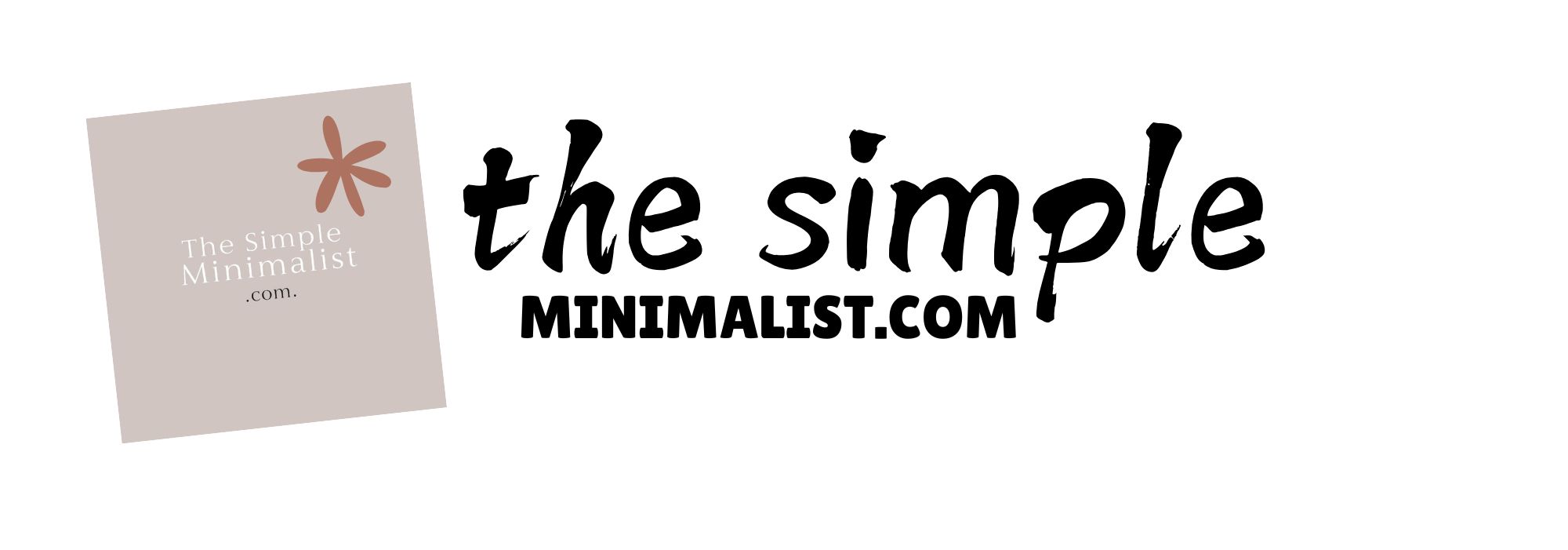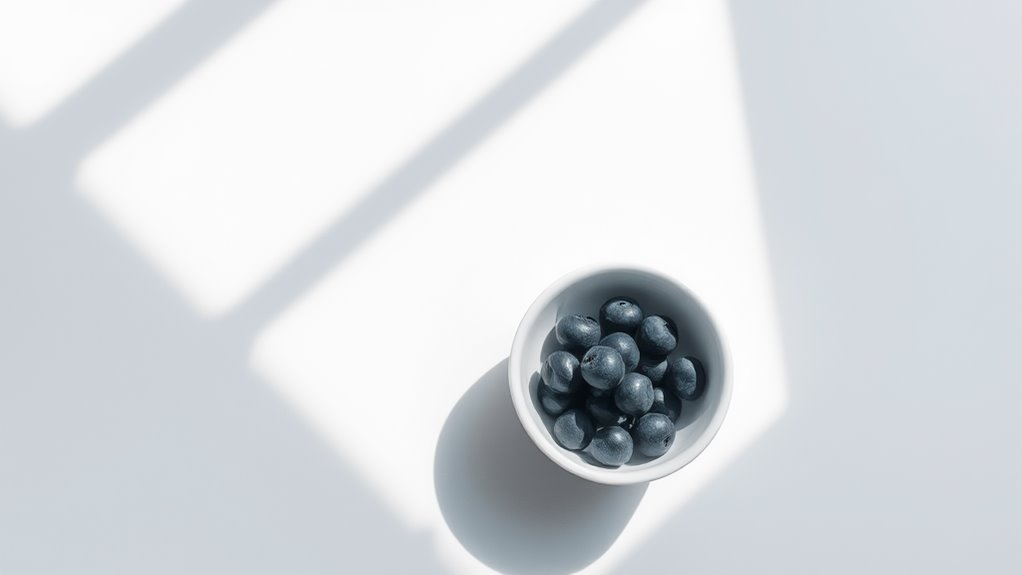The minimalist palette has a magical way of transforming spaces into calm havens using just a few colors. By focusing on soft shades and strategic pops of color, you can create a serene yet engaging atmosphere. Think of how white space can make colors stand out and elevate the mood. With the right balance, your designs can inspire both relaxation and creativity. Curious about how to choose your colors effectively? There's so much more to explore!
Minimalist Highlights
- A minimalist palette emphasizes the use of white and soft gray to create a calming atmosphere while allowing colors to stand out.
- Incorporating greenery adds vibrancy without cluttering the design, enhancing simplicity.
- Limit color choices to three to five complementary hues, focusing on soft tones for a tranquil effect.
- Utilize varying shades of the same color to introduce depth while maintaining a cohesive minimalistic aesthetic.
- Embrace the emotional impact of colors to foster specific feelings, enhancing the simplicity of the design.
Understanding the Minimalist Palette

When you think about the minimalist palette, it's easy to see how a few simple colors can create a powerful impact.
Imagine walking into a room with just white and soft gray. Doesn't it feel calming? The minimalist palette strips away distractions, allowing you to focus on the essence of a space. Incorporating greenery and seasonal accents can further enhance the calming atmosphere, bringing life to the design without clutter. Using non-toxic decorations ensures that the festive elements contribute to a safe and welcoming environment for children. Additionally, selecting color moderation as a key principle helps maintain the minimalistic aesthetic while adding visual interest. Choosing decorations that enhance the festive atmosphere can also add a cheerful touch to the design.
Choosing just a few colors can help you make bold statements without overwhelming your senses. You can play with light and shadow, adding depth to your designs.
A carefully curated color scheme allows for striking expressions while maintaining serene simplicity in your space.
Think about how a splash of color can transform a simple setting into something extraordinary. Incorporating minimalist decor principles helps ensure that each color choice serves a purpose in the overall aesthetic.
The Emotional Impact of Limited Colors
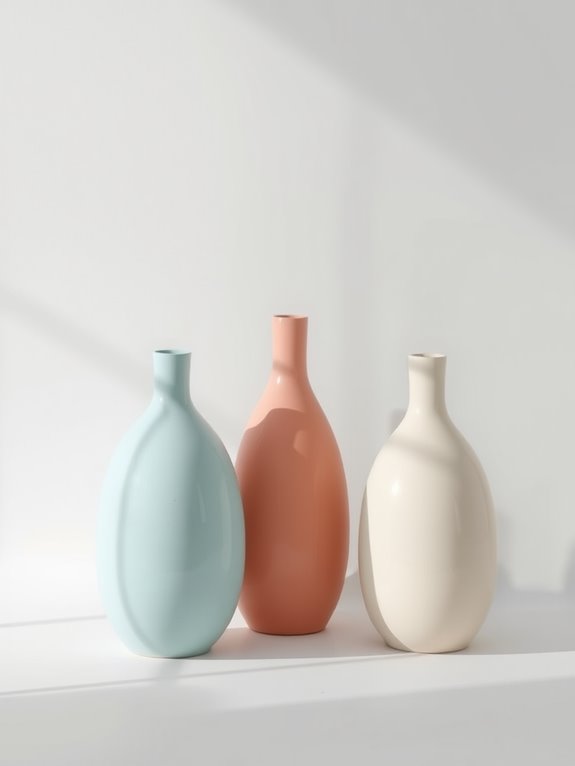
Have you ever noticed how certain colors can change your mood in an instant? The emotional impact of limited colors can be powerful, guiding your feelings and thoughts in unexpected ways. Let's explore how color psychology, mood-evoking hues, and the symbolism behind your choices can transform your space and inspire your creativity. Incorporating a color palette selection that harmonizes with your decor can significantly enhance the overall ambiance. In minimalist decor, the use of neutral tones can create a serene environment that promotes relaxation and focus. Additionally, using cozy shades of brown can reflect the beauty of autumn, further enhancing the emotional warmth of your space. The choice of soft pastel shades can also evoke a cheerful spring spirit, creating a vibrant yet minimalist atmosphere. By selecting high-quality materials for your decor, you not only ensure longevity but also maintain the vibrancy of your chosen colors.
Color Psychology Explained
Color isn't just about what you see; it's about how it makes you feel. Each hue carries its own emotional weight, influencing your mood and thoughts in subtle ways.
For instance, blue can soothe your spirit, while yellow sparks joy and energy. When you limit your palette, you focus on these feelings, creating a powerful connection with your audience.
Imagine how a simple red accent can evoke passion or urgency, drawing attention instantly. By understanding color psychology, you can harness these emotions to enhance your designs. Incorporating soft pastels can evoke freshness and tranquility, adding another layer to your minimalist approach.
Evoking Mood Through Hues
Crafting a space or design with a limited color palette creates a unique atmosphere, shaping how people feel and interact with their surroundings.
When you choose just a few colors, you can evoke powerful emotions. Imagine walking into a room painted in soft blues and whites; it feels calm and serene, inviting you to relax. Incorporating warm hues like oranges and browns can enhance the cozy feel of a space during seasonal transitions, especially when paired with durable materials that resist moisture. Adding natural materials can further enhance the overall aesthetic and emotional resonance of the space.
On the other hand, warm oranges and yellows can spark energy and joy, making you feel vibrant and alive. Each hue carries its own emotional weight, allowing you to create spaces that resonate with your intentions. Incorporating neutral tones can help maintain a calming atmosphere throughout the seasons.
Symbolism in Color Choices
When you think about the colors in your life, it's amazing how much meaning they can carry. Each hue whispers stories, evoking emotions that resonate deeply.
For instance, red might spark passion or urgency, while blue often brings calm and trust. When you limit your color choices, you sharpen their impact. Soft pastel colors can evoke a fresh, springtime feel that enhances the overall atmosphere of a space. Utilizing light and airy color palettes can further amplify this effect, creating a soothing environment. A calming color palette can also serve to unify decor elements and create a cohesive look.
Imagine a space painted in soft gray, offering tranquility, or a vibrant yellow, radiating joy. What emotions do your favorite colors stir within you?
By consciously choosing colors, you create an atmosphere that reflects your feelings and intentions. Embrace the symbolism in your palette, and let each color speak its truth. Minimalist decor essentials can enhance the emotional resonance of your color choices.
How can you use limited colors to express yourself more powerfully today?
Techniques for Creating a Minimalist Color Scheme

Creating a minimalist color scheme can feel like a revitalizing change in your design projects. Start by selecting a limited palette, perhaps just three to five colors that complement each other.
Focus on soft, muted tones or bold contrasts to create visual interest. Don't hesitate to experiment with varying shades of the same color; this adds depth without overwhelming the senses. Additionally, incorporating minimalist decor can enhance the overall aesthetic of your space. Embracing minimalist design principles can further guide your choices and ensure a cohesive look. For children's spaces, using a warm color palette can create a cozy atmosphere that resonates with the season. It's also beneficial to consider the use of natural materials as they can add warmth and texture to a minimalist design.
Experiment with soft, muted tones or bold contrasts to enhance visual interest while maintaining a sense of balance.
Consider the emotional impact of each hue—what feelings do you want to evoke? As you apply your colors, leave plenty of white space; it helps your chosen palette stand out beautifully.
Finally, remember that less is more. Trust your instincts, and don't overcrowd your design. Embrace simplicity, and watch your projects transform into stunning, minimalist masterpieces! Additionally, incorporating spring color schemes can evoke feelings of renewal and enhance the overall aesthetic of your space.
Case Studies: Artists Who Excel in Minimalism
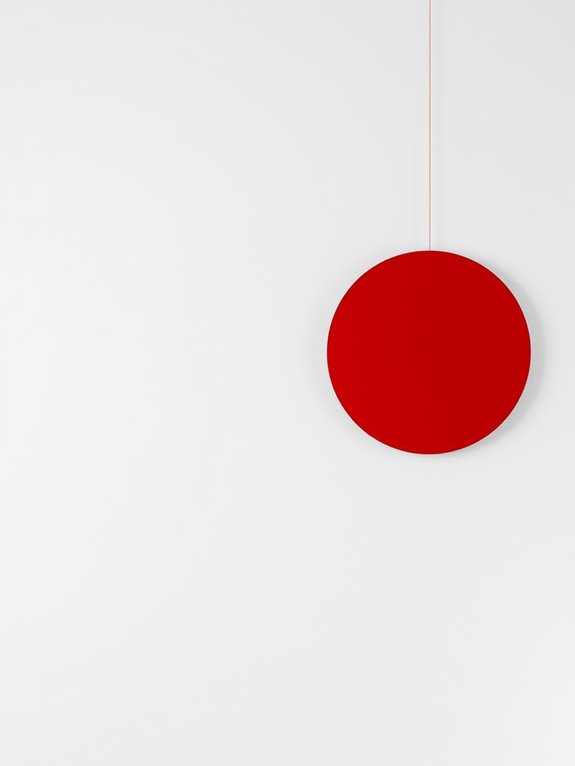
Minimalism isn't just a design choice; it's a powerful form of expression that resonates deeply with many artists.
Take the work of Donald Judd, known for his sleek, geometric forms that invite you to ponder space and simplicity. His creations often reflect the minimalist design principles that emphasize simplicity and clarity. Judd's work is a perfect example of how minimalist decor essentials can enhance the experience of space, allowing for a serene environment that encourages mindfulness.
Then there's Agnes Martin, whose subtle lines and soft colors evoke profound emotions, making you feel both calm and inspired.
What about Ellsworth Kelly? His bold, flat colors can ignite your imagination, showing how less truly can be more.
Each artist brings their unique touch to minimalism, creating pieces that challenge you to see the world differently. This powerful form of expression is often complemented by minimalist home decor, which emphasizes simplicity and clarity. By incorporating minimalist decor elements, one can achieve a balanced and harmonious atmosphere.
Minimalism in Graphic Design
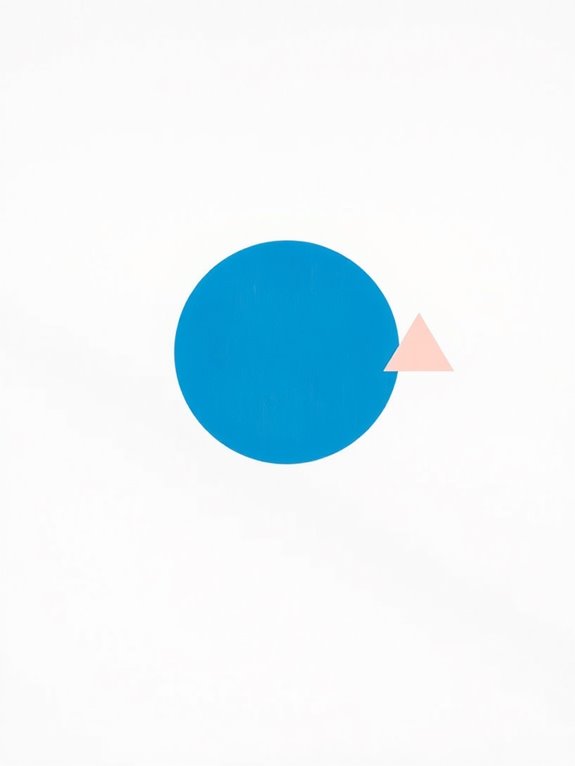
When you think about minimalism in graphic design, consider how essential color selection can transform your work. By utilizing negative space effectively, you create a striking balance that draws the viewer in. The use of neutral tones in minimalist decor can further enhance the overall aesthetic, bringing a sense of calm and clarity. Additionally, incorporating minimalist decor essentials can streamline your design process and reinforce the simplicity you aim to achieve. A focus on simplicity in design also allows for a more purposeful use of color, making each hue stand out even more. Moreover, the strategic use of natural materials in your decor can complement your color choices and enhance the minimalist vibe. And don't forget about typography—when it harmonizes with color, it elevates your design to new heights, inviting everyone to pause and appreciate the beauty of simplicity. Embracing minimalist decor can inspire a fresh perspective on how colors interact in your designs.
Essential Color Selection
Color selection can feel like a challenging task, especially in the world of minimalist graphic design, where less truly is more. You might think you need a rainbow of colors, but the magic often lies in choosing just a few.
Start by considering your message. What emotions do you want to evoke? A calm blue can inspire tranquility, while a bold red can ignite passion.
Once you've narrowed your choices, think about how these colors interact. Do they complement each other or create tension? Remember, simplicity doesn't mean boring; it invites focus and clarity.
Embrace the process! Each color can tell a story, so let your selections reflect your vision. Thoughtful color combinations can enhance overall decor and create a cohesive look. What'll your minimalist palette say about you?
Negative Space Utilization
Embracing negative space in your designs can feel like discovering a hidden treasure. It allows your visuals to breathe and creates a sense of balance that's both calming and inviting.
When you leave areas untouched, you guide your audience's eyes, making your message clearer. Think about how a simple shape can stand out against a blank background, drawing attention without overwhelming them.
Have you noticed how the best designs often let the space around them shine? By using negative space wisely, you can highlight key elements and evoke emotion.
Typography and Color Harmony
While you might think typography is just about choosing the right font, it's so much more than that; it's the heart of your design.
The way you pair fonts with colors can create a powerful visual harmony that draws the viewer in. Imagine using a bold typeface in a striking color against a soft, muted background. This contrast not only grabs attention but also guides the eye seamlessly.
Consider how each letter interacts with its color; does it evoke warmth or coolness? By thoughtfully selecting typography and color, you're not just communicating a message, you're crafting an experience.
The Role of Negative Space in Color Usage
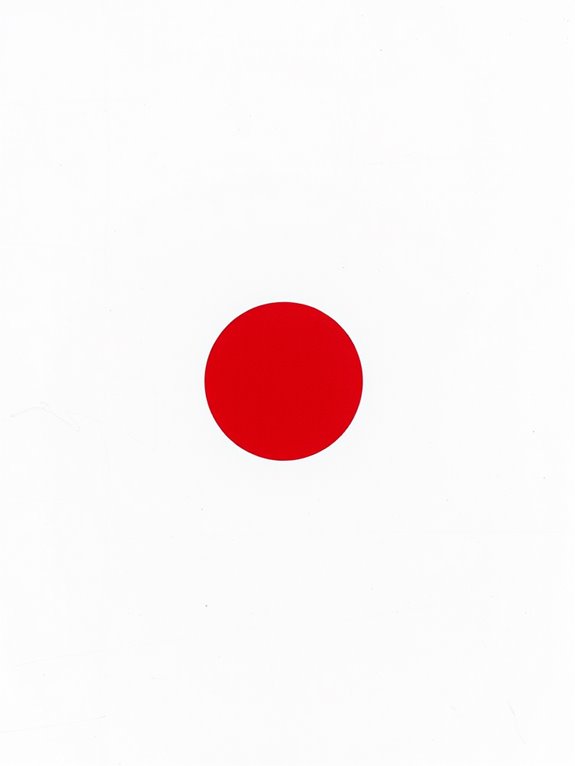
Negative space, often overlooked, plays an essential role in how colors come alive in any design. It's that quiet area surrounding your main elements, giving them room to breathe.
When you strategically use negative space, you enhance the impact of your colors, making them pop! Imagine a bright red apple sitting against a white background; the contrast draws your eye and makes that apple feel vibrant and fresh.
Isn't it amazing how less can be more? By allowing colors to stand out against negative space, you create a balanced composition that feels inviting and engaging.
How to Choose Your Limited Color Palette
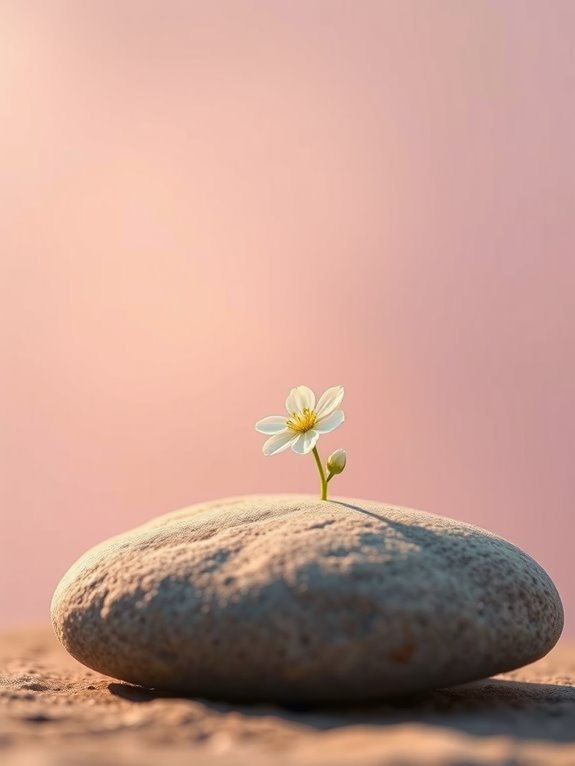
Have you ever wondered how some designs feel instantly cohesive and inviting? Choosing a limited color palette can transform your work, making it more impactful and memorable.
Start by selecting one or two dominant colors that resonate with your message or mood. Next, think about complementary shades that enhance these colors without overwhelming them.
Consider the emotions you want to evoke—warmth, calmness, or excitement—and let that guide your choices. Don't forget to include neutrals; they can balance out bold hues beautifully.
Finally, test your palette in small samples before committing. Remember, less is often more! Embrace simplicity and watch your designs come to life with clarity and purpose.
You've got this!
Minimalist Color in Interior Design

Minimalist color in interior design creates a serene and inviting atmosphere that you can truly feel at home in.
Imagine walking into a space where soft whites, muted grays, and gentle earth tones blend seamlessly. These colors not only calm your mind but also allow your personality to shine through.
You can experiment with texture by adding cozy fabrics or natural materials, enhancing the overall warmth. Think about how a single accent color could bring a pop of joy without overwhelming the space.
Why not embrace simplicity? With fewer distractions, you'll find clarity and peace in your surroundings.
The Future of Minimalism in Art and Design

As you step into the future of art and design, it's exciting to see how minimalism continues to evolve, shaping not just our surroundings but also our experiences.
Imagine walking into a space where every element feels intentional and harmonious. Minimalism isn't just about fewer objects; it's about fostering connections through simplicity.
You'll discover that artists and designers are exploring new materials and technologies, creating pieces that emphasize calm and clarity. Think of how color can enhance this experience, guiding your emotions in subtle ways.
Are you ready to embrace this fresh perspective? By engaging with minimalism, you'll find inspiration in simplicity, allowing your creativity to flourish.
The future invites you to explore, connect, and create with less.
Frequently Asked Questions
Can I Mix Different Shades Within a Minimalist Palette?
Absolutely, you can mix different shades within a minimalist palette!
It's all about balance and how you use color to create harmony. Imagine blending soft pastels or rich earth tones—each shade can enhance the other.
You'll find that a few well-chosen shades can bring warmth or depth to your space. Have fun experimenting!
Which colors speak to you? Trust your instincts, and you'll create something beautiful and inviting. Enjoy the process!
What Are Common Misconceptions About Minimalist Color Schemes?
Many folks think minimalist color schemes are boring or overly strict, but that's not true! You can create warmth and character with just a few colors.
Some believe you can't mix textures or patterns, but combining them can add depth and interest.
Others fear bold colors don't belong in minimalism, yet a pop of color can elevate your space beautifully.
Embrace the simplicity, experiment, and discover how vibrant minimalist designs can truly be!
How Does Culture Influence Minimalist Color Choices?
Culture shapes your color choices in amazing ways. Different traditions celebrate unique colors, influencing how you see simplicity.
For instance, in some cultures, white represents purity, while in others, it might symbolize mourning. These meanings can guide your decisions, helping you create spaces that resonate with your values.
Have you ever thought about how your background affects your style? By embracing these influences, you can craft a minimalist look that feels deeply personal and meaningful.
Are There Specific Colors to Avoid in Minimalism?
You might think every color has a place in minimalism, but some can overwhelm your space. Bright, neon colors often distract rather than inspire calmness.
Instead, look for soft, muted tones that create a serene atmosphere. Think gentle blues or warm whites; they invite peace without shouting for attention.
Embrace simplicity, and you'll find that choosing the right colors transforms your space into a haven.
Ready to make those choices? Let's explore!
How Can I Transition From a Vibrant Palette to a Minimalist One?
Shifting from a vibrant palette to a minimalist one can be exciting!
Start by choosing just a few neutral colors that resonate with you. Gradually incorporate these into your space, replacing bolder hues one at a time.
Don't rush—let your eye adjust to the changes. Think about how these simpler colors can enhance your mood and create a calm atmosphere.
Are you ready to embrace the beauty of simplicity? You'll love the fresh feel!
Conclusion
Embracing a minimalist palette isn't just about fewer colors; it's about discovering the beauty in simplicity. As you explore this vibrant world, think of each hue as a word in a poem, carefully chosen to evoke emotion and spark creativity. So, why not plunge in? Experiment with your own limited color scheme and let your imagination soar. Remember, in simplicity lies the power to make a profound statement. Are you ready to transform your space and art with the magic of minimalism?
